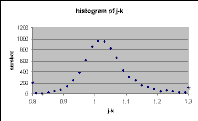
We selected all sources with j_m_7 brighter than 13.0 mag with |glat| > 40°. Figure 1 is a histogram of J-Ks colors, showing the tail to redder colors expected from the K-correction (galaxies that are farther away will have redder J-Ks colors).
 |
| Figure 1 |
To check for global problems in color, we plotted the spatial distribution of cuts in J-Ks colors. The individual figures are shown below, as well as a "movie" showing the plots in sequence from bluer to redder colors.
If there are photometric problems in the 2MASS data, they probably would show up as RA and Dec boundaries. For example, if there was a photometric shift for a block of data, then it should show up clearly by comparing the red side of the mean to the blue side of the mean. There would be an excess for one side and a corresponding deficit on the other side, due to the shift in photometry
One can check for such problems by blinking corresponding pairs of figures below (e.g., open each of the pair in new browser windows and alt-tab between them on a PC).
Nothing obviously wrong stands out in these figures. The variation in the spatial distribution with color looks like it is consistent with changes in galaxy clusters with distance. That is, they seem to move gradually in ways that are not generally correlated with equatorial coordinate boundaries.
However, readers are encouraged to stare at the movie to see if they can detect anything that looks suspicious.
Another way to confirm the reality of the clumps of galaxies would be to plot the known location of galaxy clusters on top of these figures, with the "x marks the spot" color-coded by redshift. If we see the clumps marching from lower redshift to higher redshift, then we can definitively rule out photometric errors.
T. Jarrett supplied the Abell catalog, but due to the sheer number of galaxy clusters in that catalog at redshift less than 0.1, it is not possible to see any correlation between the two catalogs.
bluest However, Figures 2 and 3 showing the bluest and reddest objects, respectively, reveal a problem. The bluest "galaxies" are nearly all located in two clumps in the southern sky, near (glon, glat) of (25°,-50°) and (225°,-50°), with only 9 found in the northern hemisphere. None of the reddest galaxies are located in those blue clumps, and are distributed fairly equally around the sky outside of those blue clumps.
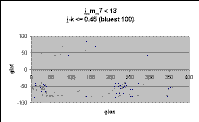
|
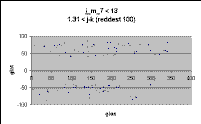 |
| Figure 2 | Figure 3 |
T. Jarrett has looked at all 143 of the bluest sources, and finds that they are mostly (63%) blue stars. About 12% are persistence ghosts (hence, they are probably flagged in the XSC as "c"). About 10% are combined galaxy+star (the center of the object is rarely placed correctly on the galaxy; the addition of the bright star complicates the situation). A few are triple/double stars. A few are unknown. A few may be real galaxies (e.g., one low surface brightness galaxy). One is a beautiful supernova remnant.
The blue stars often have a galaxy nearby (say within 30´´), clearly separated, but still lurking nearby. Further investigation of them shows that nearly all these blue sources got into the catalog, due to association with a "known galaxy" which had a bad position.
In other words, the reliability of the 143 bluest sources is near zero.
These "associated with optical galaxies" sources should not be in the XSC. As explained below, these sources did not pass the thresholds for the Catalog. Instead, these sources were put into the XSC simply on the basis of being positionally associated with large galaxies that had poor coordinates. Hence, in fact these sources are not associated with any large galaxy at all.
We searched the entire XSC for sources that should not be in the Catalog, by using the following criteria:
e_score <= 1.4;
g_score > 1.4; and
id_cat is not null.
Of the 341 sources found by this search, 171 had j_sc_sh < 4.0, with correspondingly low values for h_sc_sh and k_sc_sh. Thus, these 171 sources should not have been in the XSC, since they are not truly "E" sources. (All "E" sources must have a larger shape value, one of the primary indicators of source extent.) Instead, their e_score was forced to be 1, due to their association with a known large galaxy.
Figures 4 and 5, which are sky plots (equatorial and galactic coordinates, respectively) of the 171 sources, match closely the global distribution of the 144 bluest sources in the entire XSC, shown in Figure 6. This confirms that these sources are the source of the problems with the bluest XSC sources.
This sky plot is definitely peculiar, and must be related to the characteristics of the input galaxy catalog used for the position matching. Specifically, the coordinates are probably poor for the catalogs used for the two clumps in the southern sky.
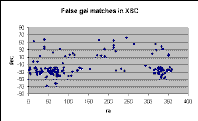
|
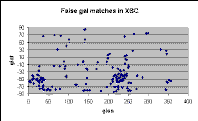
|
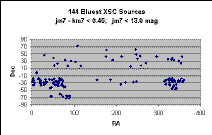 |
| Figure 4 | Figure 5 | Figure 6 |
In summary, the colors of the XSC sources look good, except for the contamination caused by the presence of sources that should not have entered the XSC. These sources should be removed from the XSC prior to release. However, if that is not possible, users should take warning about these sources and the problems they can cause for analysis.
Summary figures and a "movie" of the color distribution of XSC sources, for |glat| > 40°:
A movie of all figures, excluding bluest and reddest 100 galaxies, can be found here.
The entire sky with J-Ks < 0.45 mag:
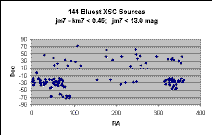 |
| Figure 13 |
[Last Updated: 2000 Jan 19 by T. Chester. Modified 2000 Jul 24 by S. Van Dyk.]